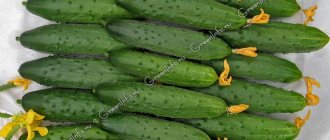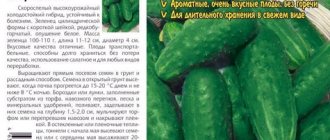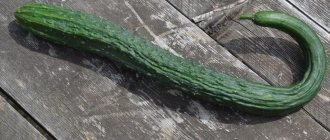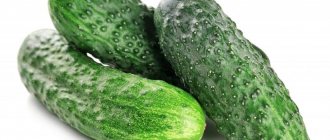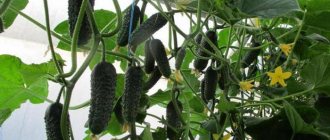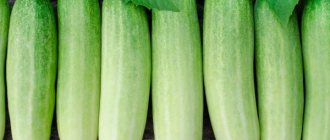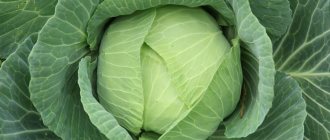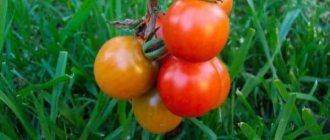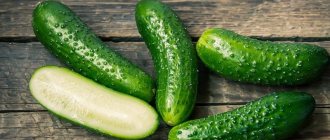Hybrid varieties of cucumbers, such as Bouquet F1, are loved by gardeners and farmers. These plants have high immunity, excellent productivity, and are also unpretentious in care. The variety will give a rich harvest; its fruits are good both fresh and as part of winter preparations.
| Landing location | Ripening time | Mode of application | Fruit length | Group | Fruit smoothness | Pollination method |
| Universal | Early ripening (35-45 days) | Universal | Medium - from 10 to 15 cm | Hybrid | Slightly lumpy | Parthenocarpic |
Cucumbers Miracle bouquet f1: description
Miracle bouquet cucumber is a hybrid, high-yielding, self-pollinating, ultra-early. Pollination by bees or other insects is not necessary for fruit set. Excellent for growing in open ground and greenhouses.
- This variety of cucumbers has excellent taste, is slightly sweet in taste and crunchy.
- The fruits are consumed fresh, in salads, canned, and pickled.
The bushes of the plant are medium-sized and have average branching. The “Miracle Bouquet” F1 cucumber is famous for its resistance to the most common diseases (powdery mildew, BOM-1, white and gray rot).
Reviews of cucumbers of the Siberian Bouquet F1 variety
This hybrid variety was obtained in 2013 and managed to win the respect of gardeners. Many have had the opportunity to experience this culture personally and leave feedback.
Some note the high yields promised by advertising. For example, one gardener harvested 30 cucumbers during the first two weeks of ripening; the fruits grew in a bouquet, as in the picture.
Others, on the contrary, complain about slow growth, small yields or poor quality of cucumbers. True, it was also said that the problem was not in the seeds, but in the soil - it simply wasn’t suitable.
Daria: “I have been growing cucumbers of the Siberian Bouquet F1 variety for several years now. I even tried planting in balcony conditions. Productivity is what you need. The bushes constantly pleased us with strong and crispy cucumbers growing like a garland.”
Karina: “I bought this variety, believing the description on the bag. However, the harvest did not turn out as expected. There are only 3-4 greens on one node, and the ripe fruits are not pimply, like in the picture, but smooth, like Zozulya. These are not suitable for winter preparations.”
Read also: Causes of yellowing onions and their elimination
Ivan Arkadyevich: “I purchased the Siberian bouquet F1 by mistake. Overall, I have no regrets - the variety is no worse than others, and in some cases even better. The harvest was rich, there was enough for the whole family to eat and for canning.”
If you have chosen this variety, it is best to try it yourself and then draw conclusions.
Characteristics of the variety
Cucumber Miracle bouquet f1 will delight gardeners with the first fruits in 40-45 days. Cucumbers of this variety can be grown in open ground, greenhouses, and film shelters. With proper care, the yield is 12-16 kg/m2.
Herman f1 cucumber is highly productive, making it possible to collect several harvests per season. In this article you can find out how to properly grow this variety and what diseases cucumber is immune to.
The fruit nodes of the plant contain 5-8 cucumbers. The fruits are dark green, cylindrical, coarsely tuberculate. The length of cucumbers is up to 12 centimeters, weight - up to 100 grams.
Planting scheme
Speaking about the planting scheme, it is worth mentioning that a comfortable area for plant growth at home should be at least 15x15 centimeters. That is, on a standard kitchen window sill you can grow a maximum of seven or eight bushes without damaging the harvest, but if you choose a successful variety, this will be quite enough, considering that there are at least two such window sills in the apartment.
In damp soil, in accordance with the above, we make planting holes one and a half centimeters deep. Lightly compact the soil, place the container on a well-lit windowsill, cover with film or glass (creating a greenhouse effect). Ventilate the planting for 5-7 minutes every day. As soon as the first growth appears, remove the coating.
Read also: How to plant and grow tomato “Pride of Siberia”
Further care, like for greenhouse cucumbers, the only “but” is that the bushes need to be moistened a little from a spray bottle every day (or every other day). Heating appliances greatly dry out the air in the apartment in winter, and for a moisture-loving vegetable this is unacceptable.
Here are the basic rules and conditions for growing cucumbers at home.
Growing
To obtain a good harvest of cucumbers of this variety, you must adhere to certain growing rules.
Seed preparation
Before planting, seeds must be checked for suitability for planting. Although all manufacturers guarantee good seed germination, they must be placed in a bowl or glass filled with water. Seeds suitable for planting will sink to the bottom, while empty or spoiled seeds will float to the surface. Growth stimulants (Ecosil, Emistim, Acrobat MC) will help to increase the germination of selected seeds; for this they are soaked in a solution for 2-3 hours.
Sowing seeds
Cucumber “Miracle bouquet” F1 is cultivated using seedless and seedling methods. With the second method, the plant develops more actively after transplantation. Planting seeds for seedlings is carried out in the following order:
- Place prepared or store-bought soil into the prepared container. To obtain strong seedlings, it is better to prepare a nutrient mixture for cucumbers yourself. Mix 2 parts peat and humus, 1 part rotted sawdust. To the resulting mixture, for every 10 kg, add 10 g of urea, 10 g of superphosphate, 10 g of potassium sulfate and 0.2 kg of ash.
- Make holes 2 cm deep, put seeds in them and cover with soil.
- Water the planted seeds generously.
- The room temperature must be maintained within 20-23 degrees.
- After the formation of 2-3 leaves, the seedlings are planted.
Expert opinion
Filatov Ivan Yurievich, private farmer for more than 30 years
As a rule, experienced gardeners plant seedlings in open ground or a greenhouse 20-30 days after sowing. The main condition before distributing seedlings into beds is the formation of several pairs of leaves on the plant and a growth of about 30 cm. 4-5 bushes are planted per 1 m2 of open ground and 2-3 bushes in the greenhouse. In a greenhouse, the bush is formed into one stem.
Planting in open ground using the seedless method:
- Make holes 50x50 cm in a specially designated, fertilized area of the garden.
- Make grooves 2-3 cm deep in the holes, put seeds in them and cover with soil.
- Water the holes generously.
- When cucumbers emerge, after the formation of 4 leaves, they are broken through, leaving 3-5 of the strongest plants in the hole.
Features of growing bouquet-type cucumbers
The peculiarity of “bouquet” cucumbers and parthenocarpic hybrids is short internodes, which increases the number of nodes on the plant and, accordingly, the total number of greens and ovaries. The group of “bouquet” cucumbers also includes bee-pollinated gherkins F1 Acorn, F1 Captain, F1 Faithful Friends. F1 Teremok.
Let's consider the most interesting aspects of the biological characteristics of cucumbers with a “bouquet” arrangement of ovaries.
- How many ovaries are formed in the nodes;
- How many ovaries grow into greens.
How many ovaries are formed in the nodes
Cucumber hybrids of the “Agro” selection consist of female flowers formed directly in the axils of the leaves, and of female flowers formed on superdeterminate secondary bouquet branches without leaves, formed in the axils of the same leaves. The stem of these bouquet shoots is so short that it is practically invisible; externally, only one large bunch is visible in the leaf axil.
The first to appear are the female flowers directly in the leaf axils (usually 2-4 of them), and later the female flowers of super-determinate bouquet shoots appear (depending on the growing conditions, there can be from 3-5 to 8-12). If the plants grow weak, then there will be no large bunches, because superdeterminate side shoots grow weak and with a small number of flowers; in addition, their formation is delayed in time.
It should be noted that ordinary side shoots are also formed in the axils of the leaves, which, as usual, are pinched to 1-3 leaves when the plants are formed. In cucumber hybrids, F1 Balcony and F1 City Cucumber, the lateral shoots are long, formed at each node, while in F1 Kolibri and F1 Machaon they are shortened (limited branching). Initially, a regular lateral shoot is formed in the leaf axil, and later a superdeterminant bouquet shoot is formed.
Thus, in “bouquet” cucumbers, the number of ovaries in a node, despite the genetic inheritance of this trait, may vary depending on the growing conditions and the location of the node on the plant.
Reduce the number of ovaries:
- excess nitrogen nutrition
- overdrying of the soil
- severe overheating
This can be noticeable in the case of very rapid growth of the main stem (the so-called “bundle resorption” effect). In the lower nodes of the main stem there may be more ovaries than in the nodes of the middle tier when the plants are “overfed” in hot weather.
Relatively low air temperatures, mainly at night (the soil temperature should be optimal: +21...24°C), optimal conditions for plant growth and development contribute to an increase in the number of ovaries in the nodes.
Read also: Green manure for tomatoes to increase productivity
How many ovaries grow into greens
In “bouquet” cucumbers, not all ovaries develop into greens - some of the ovaries dry out. When a very large number of ovaries appear on the plants, they begin to restrain the filling of greens. Due to competition for assimilates, most of the ovaries will not be able to “grow” into greens. Such ovaries seem to be inhibited in growth, remain small in size, but continue to develop biologically, while losing their taste. Therefore, it is best to collect such “non-growing” ovaries in time and use them as pickles.
2-4 commercial greens are “poured” into the nodes, the remaining numerous cucumbers will be thin, medium-sized ovaries 3-5-6 cm.
To increase the number of commercial-sized greens in super-bunch cucumbers, it is best to grow them on a loose compost substrate, feed them well (there should be no excessive fattening of the plants due to excess nitrogen), and at the beginning of fruiting, apply several foliar applications to the leaves with mineral fertilizers.
Detailed information about the range and new products of vegetable seeds of the Manul Agrofirm selection can be found on the website Author's vegetable seeds.
Care
Basic types of care for cucumbers.
Pinching or pinching cucumbers
The variety “Miracle Bouquet” F1 is self-pollinating, all flowers on the main stem are female. Therefore, pinching or pinching is not necessary.
Weeding
Weeding must be done periodically when weeds appear.
Watering
Cucumbers love high humidity and abundant watering. They are especially needed during active growth and fruit formation. Lack of moisture can lead to bitterness in cucumbers.
Do you always water your cucumbers on time?
Not really
After the moisture dries, a dense, dry crust forms in the holes, preventing the flow of air to the root system of the plant. Periodic loosening of the soil will solve this problem. You need to loosen the soil carefully so as not to damage the roots of the cucumber. You can prevent the soil from drying out quickly by mulching (filling the watered hole with grass or other organic materials).
Top dressing
Cucumbers need to be fed up to 4 times per season. These can be either folk or ready-made store remedies. Effective ready-made store-bought fertilizers are “Agricola”, “Rodnichok”, “Vegetable”, “Good Power”. When watering a plant with a fertilizing solution, you should avoid getting it on the roots, trunks and leaves of the cucumber.
Trellis garter
After properly tying cucumbers to a trellis, the yield of the bush increases and its life is extended. Without a garter, the shoots of cucumbers become intertwined, making it difficult to find holes for loosening, weeding and watering. Cucumbers need to be tied when they reach a height of 40-50 cm, guiding the plant up along the vertical or horizontal guides of the trellis. A plastic mesh can be used as guides.
Description of this variety
Any cucumbers that have bouquet-type ovaries save space on the site. This means that you can grow another cucumber in the saved space or use it in some other useful way.
And the number of cucumbers that were removed from the entire garden will be provided by only 1 bush of cucumbers of this variety. That is, a cucumber harvest in a small garden is not a utopia, but a reality if this particular variety is cultivated. Another advantage is that it is very rich in vitamins. As, indeed, other cucumbers.
- The yield is about 30 kg per 1 m².
- The yield is about 30 kg per 1 m².
- If we talk about how tasty greens are, then their taste is at a high level.
You can eat them fresh, or pickled, or in a marinade. Also, the lack of bitterness is a genetic trait. If we talk about the pulp of these fruits, it is quite dense and crispy.
Diseases and pests
Cucumber “Miracle Bouquet” F1 is resistant to the most common diseases. Diseases occur extremely rarely, but when growing a plant the following problems may arise:
- Aphid. Insects settle on cucumber leaves, causing them to curl and dry out. The drugs Decis and Arriva will help get rid of aphids. Preventing the formation and destruction of ant nests in the garden will also help in the fight against aphids.
- Ants are the main distributors of aphids; for them they are like “cows” that give milk.
Aphids and ants
- Root rot. When temperature changes and high humidity occur, brown spots appear on the roots, the stem dries out, followed by the leaves drying out and the plant dies. It is necessary to avoid watering and sprinkle sick plants with ash. If this does not help, the plant must be dug up, the soil treated with copper sulfate, and the plant burned. Prevention of the disease is disinfection of the soil and treatment of seeds before planting.
- Anthracnose. Brown spots appear on the leaves due to high humidity. The cucumbers begin to rot and taste bitter. Affected plants must be removed and the soil disinfected with potassium permanganate.
Reviews about the variety from those who planted
“Siberian Bouquet” is in high demand among gardeners living in harsh climatic conditions. Disease resistance and cold resistance allow for high yields.
The hybrid will be an excellent choice for summer residents with a small plot. Thanks to the presence of a bouquet type of ovaries, you can plant just a few cucumber bushes in the beds to provide all household members with green vitamins.
Super bunch cucumbers:
I consider the “Bouquet” variety to be one of the best for preservation. Cucumbers look great on the table in winter, and I seal them in liter jars. You can also eat them fresh, but you should first go through the gherkins with your hands to remove any protruding spines - otherwise you will feel them in your mouth while eating. Cucumbers with good density, I have not observed any voids in the 4 years that I have been growing the variety. It is not affected by any diseases, but the soil has to be fertilized to increase productivity. Also, every 2 years we change the area for planting cucumbers. We usually prepare the land for planting that was previously used to grow potatoes or cabbage. I don’t plant dry seeds - I soak them in advance and germinate them on the windowsill, then plant them in plastic cups with peat and wait for the sprouts to appear. I take the sprouts with a lump of earth out of the cups and place them on pre-made beds. The distance between the sprouts is 30-50 cm. Cover the area with film, it is on the arcs. In sunny weather we open it, and in cold spring we keep it under film until 4-5 leaves appear. Then we remove the greenhouse and put up the trellises. From a bush you can get up to 5 kg of cucumbers per season.
The good thing about this variety is that cucumbers appear 5 weeks after planting the seeds, and the harvest can be harvested until the end of summer. It does not require special care, but if you put in more effort, the yield increases significantly. It is preferable to plant seeds for seedlings in prepared soil and then, after warming, transplant them into open ground. The soil for growing seedlings should be light, not acidic, and sufficiently fertilized. You should also plant seedlings in soil with sufficient fertilizer. We apply bird droppings in the fall and in the spring additionally - potassium-phosphorus fertilizers. Before planting seedlings, we stretch plastic film over the beds for a day - this way the soil warms up faster and the seedlings are completely accepted. This variety is not susceptible to powdery mildew and no treatment is required. Cucumbers grow smooth, with thin skin and do not have bitterness or hollowness in any weather conditions. It is important to keep the soil moist. Depending on the weather, we water the cucumbers either every other day or daily. We do this in the 2nd half of the day. Picked cucumbers store well - up to a week in the refrigerator. Productivity is stable until the beginning of autumn.
Read also How to grow Indian onions at home
I liked the “Bouquet” cucumber; it produced a harvest in the greenhouse in record time - 40 days after planting 30-day-old seedlings. The cucumber grows on a vine, so when planting, I immediately tie it up. This variety is not thickened, the greenhouse has not turned into a jungle. Cucumbers are delicious, growing in bunches of 2-6 cucumbers. I cut more often so that new ovaries appear sooner. It is better to pinch the main stem, leaving 2 side stems. It is better to remove all stepsons and leaves.
The cucumber variety Siberian Bouquet F1 is universal in every sense. It is suitable for growing in open ground, in a greenhouse, it blooms and sets early, is slightly susceptible to diseases, the fruits are used for salads and winter preservation.
From the name it is clear that flowering and fruiting occur in a bouquet manner. From 2 to 6 flowers and ovaries appear on one node. This variety of cucumbers quickly became popular among gardeners - a branch with so many fruits looks very attractive. In addition, the cucumbers grow crispy, juicy, and tasty.
Let's figure out how true the description of the variety and the photographs on the seed packages are.
Photo
The photo shows the appearance of the handsome cucumbers of the “Miracle Bouquet F1” variety. In this photo you can see ripe vegetables, female flowers of the plant and the formation of cucumbers in the fruit nodes.
Care after disembarkation
The Siberian Garland cucumber variety surprises with its generous fruiting. In order for the hybrid to show its best qualities, it will require special attention and care.
Plants are not capricious and do not require intense labor. But the hybrid is so called because it is capable of producing more than 8 fruit ovaries, each of which contains 10-15 fruits. To have enough strength to bear such a harvest, the bushes need help. There are several rules you need to follow.
Watering
Cucumber plantings need to be watered only when the soil dries out after the previous watering.
If the rule is not followed, you can expect unpleasant consequences:
- If watering is delayed, the leaves will wilt and the taste of the cucumbers will change dramatically. Due to lack of watering, the plant may drop unripe fruits.
- When overwatering, excess moisture may appear, creating favorable conditions for the formation of fungal diseases.
To prevent the soil from “crushing”, it should be loosened after watering. This will allow air to flow to the roots, and weed roots can be easily removed by loosening.
Feeding
Every 10-14 days of planting you can feed. Fertilizers are applied until the fruits appear. Suitable for feeding:
- various infusions (herbal, onion peel);
- urea;
- ash.
Attention! At the moment when the fruits appear, stop feeding the cucumbers - otherwise the taste of the crop will spoil.
Forming, pinching, harvesting
Bushes are usually formed into one stem, otherwise there will be no decent harvest. Up to 4 leaves (including it), all stepsons and leaves are torn off. Only the main, main shoot is left.
It is imperative to pick cucumbers in a timely manner. Delay in harvesting leads to unpleasant consequences:
- reduction in yield;
- excessive thickening of plantings;
- additional shade and dampness - cucumbers may get sick.
It is necessary to ensure that winged “guests” do not visit the plants. If traces of insects are noticed, the cucumber plantings should be treated with special preparations - insecticides.
